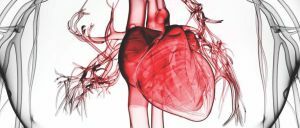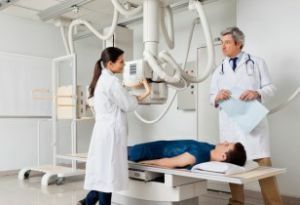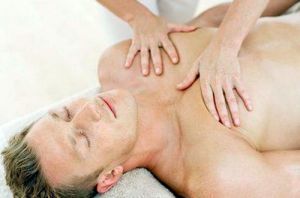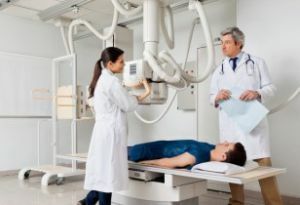 Intercostal neuralgia: "sparks flying from the blade".
Intercostal neuralgia: "sparks flying from the blade".
Already if you compare the edge with a saber blade, which, taking the ends, was bent in a semicircle: curved arc, wide and flat, there is a real sharp edge and a "boot" - a dull "nape" of the blade.
The lower sharp edge of the rib - more precisely, of each of the ribs - is formed due to the fact that there is a hollow along the inner side, into which the "vascular-neural bundle" is laid: the "power cable" of the intercostal nerve and the same name( here everythingintercostal) vein and artery.
A "scabbard" for the bone blade is attached in the intercostal spaces - again intercostal - muscles, internal and external, widening the chest on inspiration and compressing it on exhalation. Each rib is attached: in front - to the sternum with the help of cartilaginous "welding", and behind - through the head of the rib and "pit" in the body of the vertebra - a real full joint is formed.
Contents
- Anatomically-causal ligament
- Pain, pain, pain. .. And again about the symptoms of
- It hurts under the left breast - it means a heart attack?
- What else can be misleading?
- Neuropathologist summarizes
- What can I do at home?
- The possibilities of drug-free treatment
- When drugs can not be dispensed with
- And if neuralgia is not treated?
- Do not forget about doctors
Anatomically-causal bunch of
It would seem that everything is thought out to the smallest detail and all requirements of "safety engineering" are met. But life is amazing and not always beautiful, and in nature there are toxins.
These are microbial, viral( tubercular, brucellosis, influenza) and other chemical compounds that affect the delicate nerve tissue, including the intercostal nerve, which begins in the spinal cord in the thoracic part of the brain.
From here comes another danger to the "power cable" that supplies electrical energy for the life of the internal organs contained in the chest. The danger arising from dozens of years of illiterate exploitation of the spine, the name of which: osteochondrosis. His "dull teeth" - osteophytes( marginal salt deposits on vertebral bodies) are able to "snack" the nerve at the level of its exit from the spine - in the intervertebral foramen.
The possibility of a mechanical trauma( infringement) of the nerve is dangerous and abruptly converging vertebrae is also incredibly high. For not particularly  trained people, this can happen when falling on your feet with the appropriate height, either because of a "stumbled" leg, or simply with a sharp shake. For weightlifters and those engaged in heavy physical labor, the reason is a sharp force load( axial impact in the spine) when the rod is raised or heavy weights are moved.
trained people, this can happen when falling on your feet with the appropriate height, either because of a "stumbled" leg, or simply with a sharp shake. For weightlifters and those engaged in heavy physical labor, the reason is a sharp force load( axial impact in the spine) when the rod is raised or heavy weights are moved.
And now for one of the reasons for this impact - "vertically" or "horizontally" - there is a phenomenon of intercostal neuralgia.
The second half of the word "algos" is translated as "pain", and this pain is so strong that it makes one think of even myocardial infarction( if the intercostal neuralgia shows its symptoms on the left).
But other reasons are also possible, according to which intercostal neuralgia develops:
- age and metabolic diseases( menopause, diabetes), diseases of the digestive tract, blood, vessels and heart, habitual intoxications( including medicamentous ones) that lead to a change in bone structureOsteoporosis;
- compression of nerves in the narrowed bone-tendon canals, or compression by a tumor, scar tissue( and for another reason).
Pain, pain, pain. .. And again about the symptoms of
Symptoms of intercostal neuralgia are most indicative when the nerve( nerves) is affected by an extremely strong poison, released by the herpes zoster virus. But the osteochondrosis complicated by the development of neuralgia is also very demonstrative.
The pain comes suddenly and is so strong that it can cause even involuntary urination, a person with a low threshold of pain sensitivity is able to lose consciousness - a faint occurs.
In an easier version, the body reacts to sudden sharp pain with nausea( or vomiting), dizziness and headache with "darkening" in the eyes, "cold" in the hands and feet, blushing or flushing of the skin, often "breaks sweat".In general, the standard response to a pain close to the shock threshold.
 There is pain in intercostal neuralgia "suddenly and nowhere": a gusty, sharp( or not so sharp) movement - sipping after a long sitting at the computer, coughing( usual for smokers phenomenon), laughter, and now "covered" like a fur coat!!
There is pain in intercostal neuralgia "suddenly and nowhere": a gusty, sharp( or not so sharp) movement - sipping after a long sitting at the computer, coughing( usual for smokers phenomenon), laughter, and now "covered" like a fur coat!!
Further it does not become easier: having lived the first decisive attack of pain and panic: did death come in the person of a heart attack?- the victim of the disease becomes more cautious in the movements and manifestations of feelings, noting that in these cases the pain intensifies.
He then discovers that the pain is localized in severely defined intercostal spaces that become hyperemic and sharply sensitive to touch, reacting to it by increasing pain. And then - also an endlessly long "echo" from touching in the form of "ant form", burning, tingling or short-term twitchings. This creates a protective "casing" - spasm of the intercostal muscles, microsorningly cutting, warn: carefully, the tunnel is temporarily closed!
For repair.
Only the body can cope with repair very rarely - the modern person is too effeminate. He calls the ambulance service and doomedly drop: come urgently, I have a heart attack. .. Of course, myocardium!- and calls the address.
Is it a heart attack? Does the stone come out of the liver? Or pleurisy?
You can think about these diagnoses, depending on the level of the process. But the doctor who arrived, taking off the ECG, hastens to reassure: with myocardial infarction and angina the character of the pains is different.
Hurts under the left breast - means a heart attack?
Than stenocardial pains differ from signs of intercostal neuralgia: 
- as quickly arise, so also quickly disappear;
- do not depend on body movements and are not capable of sharply increasing with them;
- are not wearing a girdle;
- have a location located behind the sternum.
Once again on how to distinguish between symptoms of intercostal neuralgia from heart pain:
What else can be misleading?
Against pleurisy( despite the increased pain with deep inspiration, leading to gentle, shallow breathing) says the absence of signs of microbial-viral damage to the pleura: there is no increase in temperature, intoxication and other signs.
There are no typical signs of renal or hepatic colic - there is a typical general reaction to pain.
Yes, the pains are painful, but they are of a neurological nature. This is either a "lumbago" in the thoracic region - the pain increases with pressure in the paravertebral points, or an infectious disease - just started herpes zoster( shingles).A rash will come later.
Weighed down by this information, the patient plunges into the darkness of his first sleepless night. Or immediately goes for explanations and treatment to a neurologist.
The neurologist summarizes the
After a detailed questioning( previous condition, habits, treatment and operations) and examination for clarification - the currently presumed diagnosis - it is suggested to undergo the necessary minimum of studies in the form of:
- X-ray of the spine and thorax for analysis of the bone system condition;
- general analysis of urine and blood( general and biochemistry) - to eliminate systemic disease and determine the general condition and capabilities of the body.
 To investigate not only bone, but also soft tissue allows the use of CT( computer tomography) and MRI.
To investigate not only bone, but also soft tissue allows the use of CT( computer tomography) and MRI.
The use in diagnosis of myelography( with the introduction of a contrast medium in the spinal canal) reveals all the nuances of life of the spinal cord and nerve spinal roots, and the use of contrast discography - the state of the discs between the vertebrae.
The possibilities of electro-spondylography - the newest page in vertebrology - allow to evaluate all the subtleties of the "state of standing" of the spinal column and the influence of the therapeutic measures carried out on it.
What can I do at home?
Treatment of neuralgia of the intercostal nerve is the healing of the cause that caused it. Therefore, all manipulations conducted at home, you need to get approval from a treating neurologist.
The acute period of the condition requires bed rest for at least 1-3 days. As well as finding the spine in the most physiological position, to achieve which it is necessary to lay the body on a shield, placed under the mattress to create an impermeable-firm and even surface.
If the intercostal neuralgia has just begun its journey along the nervous pathways, as a method, treatment at home with  is permissible for the use of sources of dry light heat: a heated sand, salt, electric hot water bottle, mustard plasters, pepper plaster on the problem area.
is permissible for the use of sources of dry light heat: a heated sand, salt, electric hot water bottle, mustard plasters, pepper plaster on the problem area.
Movements - sparing spine, as smooth as possible, without sharpening when tilting and turning the trunk( it is better to avoid them at all), with the exception of long sitting and the perfect exception of lifting weights.
It is effective to wear a corset for a few days or create a tight bandage-pulling with a wide cloth( towel).
For relieving painful pains, lubrication( without rubbing!) Of the entire back - except for the spine and paravertebral zones - with a mixture of tinctures of iodine and glycerin, carefully mixed by shaking in a dark glass bottle, is applicable. The procedure is repeated 15 times( through the night), using for sleeping linen from natural( cotton, linen) fabric.
In addition, it is mandatory to perform therapeutic gymnastics prescribed by a doctor.
Possibilities of drug-free treatment
Treatment of intercostal neuralgia can be done without using medicines using the following methods:
- massage;
- acupressure;
- acupuncture;
- manual therapy;
- setting cans.
In more detail about each method of treatment:
- With massage movements of the hands with warming ointment or cream applied on them, deep warming-relaxation of muscles creating a protective "corset"( or, conversely, leading to compression of the intercostal nerve) is achieved. Produced in a sitting position with rubbing and stroking the intercostals with fingertips and the subsequent kneading of all the spinal muscles.
- In contrast to the previous method, acupressure compresses physiological and bioenergetically
 associated with the diseased organ of the point, resulting in pain relief, relaxation and a quick effect by stimulating the body's own defense mechanisms.
associated with the diseased organ of the point, resulting in pain relief, relaxation and a quick effect by stimulating the body's own defense mechanisms. - acupuncture ( acupuncture), moxibustion, and laser therapy methods are similar physiologically and bioenergetically justified, allowing rapid neutralization of muscle imbalance in deep back muscles with the elimination of pain.
- Treatment of intercostal neuralgia by setting on the back massage cans pursues the same goals, being a simple and harmless for the body technique( provided there are no contraindications to its use).
- To manual techniques are used after the end of the acute period. They are included in the return to the proper places of the bony structures displaced from them in the course of the disease and the muscles and ligaments that serve them, and are produced exclusively after manual diagnosis. As a result of the action, the diameter of the narrowed tunnels( bone-tendon and bone-muscular) comes back to normal and the function of the restrained nerve is restored.
Like all the above methods, the methods of physiotherapeutic treatment with the application of:
- magnetic or electromagnetic field are equally applicable and especially relevant in the case of intercostal neuralgia in pregnant women;
- ultrasound, ultraviolet and infrared radiation;
- electro- and iontophoresis, with a minimum dose of drug for the fetal risk.
When drugs can not be dispensed with
What medications do modern neurologists recommend to treat intercostal neuralgia?
It is advisable to use preparations of the category of analgesics, anti-inflammatory non-steroid agents, muscle relaxants, replenishment of B-vitamin deficiency;in particularly severe cases, blockades with anesthetics and hormones are applicable.
Specific drugs that are included in almost any treatment regimen if the patient is diagnosed with intercostal neuralgia:
- The first category includes the preparations Analgin, Sedalgin, Spazgan and the like, consumed per os.

- The second, most commonly used group is represented in various dosage forms of Voltaren, Ibuprofen, Indomethacin, Piroxicam, Diclofenac ( injections, ointments, capsules, tablets).
- The preparations containing the poisons of animals include preparations Virapine, Apizarthron, Vipratox, Viperalgin ( in the absence of allergies they can be replaced by "sitting down" on the sore spot of stinging bees - apitherapy).
- The effect is also brought by the applications Dimexid .
- Miorelaxing agents( Sirdalud, Baclofen, Tizanidine, clonazepam ) are used in the treatment of severe forms of intercostal neuralgia.
- The peak of treatment is the use of blockades with Novocaine or Lidocaine .
- In exceptional cases, the problem is solved using glucocorticoid Prednisolone and other substances of this class.
- Insomnia caused by intercostal neuralgia uses sedative and hypnotics .
- To persons suffering from gastrointestinal lesions, dosage forms of Ketoprofen-Flexan ( in the form of a gel, rectal suppositories or prepared immediately before the injection of an injection) are strongly recommended.
And if neuralgia is not treated?
Intercostal neuralgia itself is not dangerous, but if it is not healed, then the situation is fraught with a repetition of the experiences of suffering.
Neuralgia can also become the tip of a thread, leading to a whole bunch of problems with the health of the body and its individual organs, or to the problem of one, but archival( such as a tumor), so it requires a serious attitude towards itself.
To forget about doctors, try
To prevent the development of neuralgia and its transition to a chronic form allows an active lifestyle with sufficient( in joy for the body) mobility, both its individual parts and their totality. Encouraging yourself to be an excessive mass( both fatty and muscular in the "swing" -bodybuilder) leads both to problems with the vertebrae, and to the spaces between the ribs.
Hiking, playing games, dancing in combination with hardening of the body, competent handling of moving weights and with your own body - these are the "keys" that lock the door with inscriptions: fatigue, old age, illness.
In the case if, after all, "covered", you should entrust your patients with intercostal space to the hands and mind of doctors.



